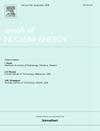A detailed review on critical flow experiments and models
IF 1.9
3区 工程技术
Q1 NUCLEAR SCIENCE & TECHNOLOGY
引用次数: 0
Abstract
Critical flow is a significant phenomenon in reactor safety analysis, which has remained a research focus for several decades. The critical flow rate determines the rate of coolant loss in the reactor and the rate of pressure relief in the primary loop. Owing to the multiplicity of parameters influencing critical flow and the complexity of the flow phenomenon, there exists an incomplete cognition of the critical flow phenomenon at present, and precisely calculating the critical flow rate under various working conditions is extremely challenging. Consequently, this paper presents a comprehensive review of the experimental and theoretical studies on critical flow carried out in various thermodynamic regions. It summarizes the current progress and deficiencies in experimental research and concurrently compiles the experimental research data to offer database support for other researchers engaged in theoretical studies of critical flow. A brief but comprehensive overview of the existing theoretical models and general modeling framework for critical flow phenomena is provided. It is conducive to the further understanding and investigation of the critical flow phenomenon.
临界流动实验和模型的详细综述
临界流量是反应堆安全分析中的一个重要现象,几十年来一直是研究重点。临界流速决定了反应堆中冷却剂的损失率和一回路的泄压率。由于影响临界流量的参数众多,流动现象复杂,目前对临界流量现象的认识还不全面,精确计算各种工况下的临界流量极具挑战性。因此,本文全面回顾了在不同热力学区域开展的临界流实验和理论研究。它总结了当前实验研究的进展和不足,同时汇编了实验研究数据,为其他从事临界流理论研究的研究人员提供数据库支持。对临界流现象的现有理论模型和一般建模框架进行了简要而全面的概述。这有利于进一步理解和研究临界流现象。
本文章由计算机程序翻译,如有差异,请以英文原文为准。
求助全文
约1分钟内获得全文
求助全文
来源期刊

Annals of Nuclear Energy
工程技术-核科学技术
CiteScore
4.30
自引率
21.10%
发文量
632
审稿时长
7.3 months
期刊介绍:
Annals of Nuclear Energy provides an international medium for the communication of original research, ideas and developments in all areas of the field of nuclear energy science and technology. Its scope embraces nuclear fuel reserves, fuel cycles and cost, materials, processing, system and component technology (fission only), design and optimization, direct conversion of nuclear energy sources, environmental control, reactor physics, heat transfer and fluid dynamics, structural analysis, fuel management, future developments, nuclear fuel and safety, nuclear aerosol, neutron physics, computer technology (both software and hardware), risk assessment, radioactive waste disposal and reactor thermal hydraulics. Papers submitted to Annals need to demonstrate a clear link to nuclear power generation/nuclear engineering. Papers which deal with pure nuclear physics, pure health physics, imaging, or attenuation and shielding properties of concretes and various geological materials are not within the scope of the journal. Also, papers that deal with policy or economics are not within the scope of the journal.
 求助内容:
求助内容: 应助结果提醒方式:
应助结果提醒方式:


